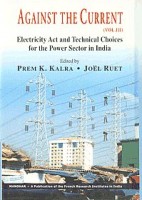Against the Current (Volume III) Electricity Act and Technical Choices for the Power Sector in India

- Year :2006
- Pages :219
- Price :500 Rs
- ISBN :81-7304-684-0
- Editor :Manohar-CSH
The State Electricity Boards (SEBs) present huge potential for daily change in the lives of a billion-strong Indian
population. Often described as nearly impossible to reform, SEBs offer huge untapped potential for higher technological efficiency, that in turn could mean reliable electricity
for day-to-day life, reduced bills for the users and the public exchequer, higher environmental sustainability.
For this potential to appear clearly in the public debate,
the so-called ‘technicalities’ of the power sector should no longer be the monopoly of a few specialists and technocrats. And indeed, India’s history of economic regulation
has entered into a new era when, in the power sector, the model of ‘independent regulation’ for utilities got enacted through the Electricity Regulatory Commissions Act,
1998, then followed by the new Electricity Act 2003. The regulatory commissions gained a saying in virtually all technical matters within the utilities. The biggest chasse
gardée of the State Electricity Boards engineers had not resisted.
This volume comes as third in a series on the power sector reforms in India. The series attempts
at understanding (i) the organizational tasks, (ii) the tariffs aspects, (iii) the role of the private, (iv) the role of technology in the complex, variegated, state-specific Indian
scenario.
A clear and sound public debate of tariffs, service, advantages and limits of privatization of the Indian scenario can only come from the an informed
assessment of current margins in technological enhancement of SEBs and on the relevance of the Act in framing such a new Indian power system. This volume wishes to
contribute to this.
Contents
Acknowledgements
Contributors
Introduction
PART I: ELECTRICITY ACT AND EFFICIENCY IN GENERATION, DISTRIBUTION
1. Electricity Act and ‘Enterprisation’ of the State Electricity Boards – JOEL RUET
2. Central Act and State
Acts – G. SUBBA RAO
3. Markets through the Back Door – SUDHA MAHALINGAM
4. Benchmarking of Electricity Distribution Companies in India – PREM K. KALRA, V.P. SINGH and YOGESH K. BICHPURIYA
PART II: TECHNICAL CHOICES AND MANAGEMENT
5. Need for Distribution System Reforms and Customer Training – A.K. SAXENA and PREM K. KALRA
6. Application of Information Technology to Improve Performance in Power Distribution – SANJAY GUPTA
7. Broad Technology Choices and Technology Mix for the Power Sector – R.K. BELAPURKAR
8. Voltage Control through Reactive Power Management – Case Studies – MAHENDRA KUMAR
9. Transmission Line Congestion Management Using Bid-Areas Division Technique – D.P. KOTHARI and PARUL GOYAL
10. Integrated Resource Planning in Supply Side Management in Power System – PREM K. KALRA, YOGESH K. BICHPURIYA and V.P. SINGH
PART III: MACRO-LEVEL ASPECTS: WHAT TO DO AS REFORMS?
11. A Benchmarking of Performance of Indian State-level Electricity Utilities in the Post-Liberalization Period – N. BALASUBRAMANIAM
12. Generation Choices: A Retrospective Account of the Ninth Plan – JOEL RUET
13. Electricity Reforms, Firm-level Responses and Environmental Implications – DEEPA MENON-CHOUDHARY, P.R. SHUKLA, TIRTHANKAR NAG and DEBASHISH BISWAS
14. The Act as a Base for Rethinking Technology and Managerial Mixes – JOEL RUET








